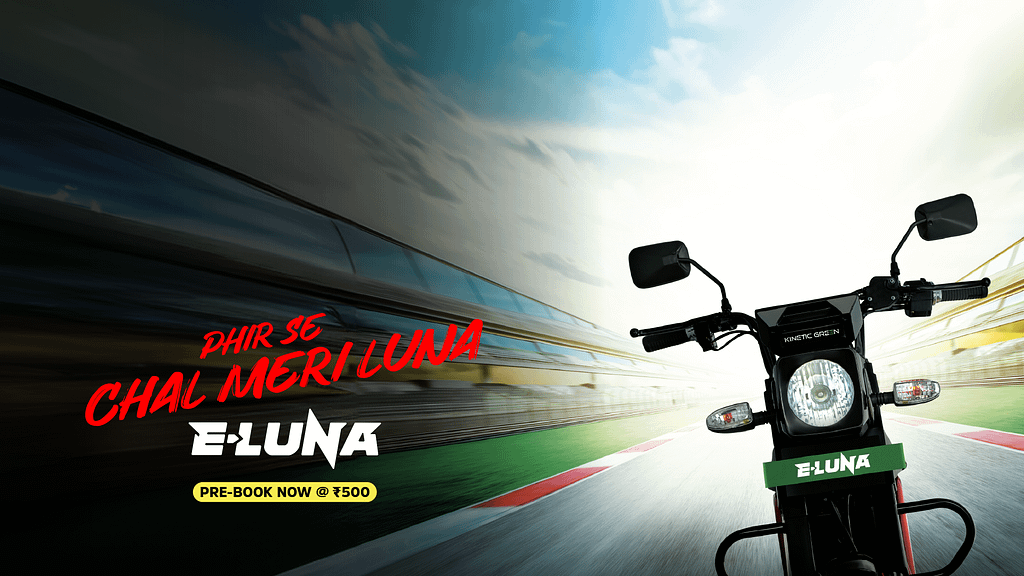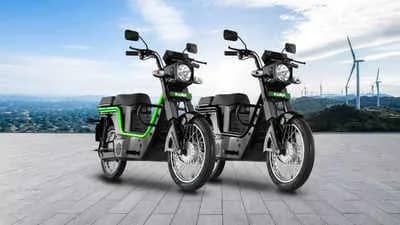The rumble of a single-cylinder engine and the iconic slogan “Chal Meri Luna” (“Go My Luna”) was once synonymous with Indian streets. Now, after 2 decades, the Luna returns, not with a gasoline heartbeat, but with the silent hum of electricity, marking a significant shift for Kinetic and the Indian electric vehicle (EV) landscape. Let’s delve deeper into this Kinetic E-Luna, beyond the nostalgia and affordability narratives, to explore its true significance and potential impact. The same company that launched the original Luna in 1972 – Kinetic Engineering – is behind the E-Luna relaunch. Currently, the company operates under the name Kinetic Green.
Table of Contents
📍 𝓝𝓮𝔀 𝓓𝓮𝓵𝓱𝓲 | 𝐥𝐚𝐮𝐧𝐜𝐡 𝐨𝐟 𝐊𝐢𝐧𝐞𝐭𝐢𝐜 𝐆𝐫𝐞𝐞𝐧'𝐬 𝐄-𝐋𝐮𝐧𝐚 pic.twitter.com/c96nSFrNk1
— Nitin Gadkari (@nitin_gadkari) February 7, 2024
features of the kinetic e-luna
The Kinetic E-Luna, a modern electric version of the iconic Luna, comes with several features that make it a practical and attractive choice for urban commuting. Some of the key features of the Kinetic E-Luna include:
- Rugged steel chassis and stylish metal body for durability and a sleek look.
- Swappable battery, offering flexibility and convenience for charging.
- The foldable rear seat, allows for easy conversion to a large carrying space.
- Digital instrument console with a Distance to Empty (DTE) indicator, providing essential information to the rider.
- USB charging port for added convenience.
- Large carrying space, enhancing the utility of the electric moped.
- 16-inch wire-spoke wheels and 170mm best-in-class ground clearance for stability and maneuverability.
- Three riding modes, a side-stand sensor, and a combi-braking system for enhanced safety and control.
- Available in five color options: Mulberry Red, Pearl Yellow, Night Star Black, Ocean Blue, and Sparkling Green.
The E-Luna is designed to offer a range of 110 km on a single charge, making it a practical and eco-friendly option for daily travel. It also comes with a payload capacity of 150 kg, catering to various transportation needs. The electric moped is equipped with a 2.2 kW hub motor, enabling it to reach a claimed top speed of 50 km/h.
the battery capacity of the kinetic e-luna
The Kinetic E-Luna, an electric moped launched by Kinetic Green, comes with a 2kWh lithium-ion battery that is IP67-rated and fast-charging. The battery is swappable, offering flexibility and convenience for charging, and can be charged in four hours. The E-Luna is available with three battery options: 1.7 kWh, 2 kWh, and 3 kWh, offering a range of 110 km, 110 km, and 150 km, respectively. The battery capacity of the Kinetic E-Luna is 2 kWh
warranty period for the kinetic e-luna
The warranty period for the Kinetic E-Luna is 40,000 kilometers or 36 months, whichever comes earlier. This warranty coverage reflects the company’s confidence in the quality and reliability of the electric moped.
Price of E Luna?
Price: The E-Luna comes in three variants with different prices:
- Base model: Rs. 69,990 (ex-showroom) – Range: 80km
- Mid-range model: Rs. 74,990 (ex-showroom) – Range: 100km
- Top-end model: Rs. 79,990 (ex-showroom) – Range: 125km

More Than Nostalgia: A Strategic Electric Luna
While the emotional pull of Luna’s legacy is undeniable, Kinetic isn’t solely banking on sentiment. The E-Luna targets a specific, underserved segment: the Rs 25,000-30,000 monthly income group currently reliant on public transport or shared mobility solutions. This strategic move taps into the booming demand for affordable EVs, a segment expected to reach 10 million units by 2030 (Economic Times, 2023). It’s not just about reviving a beloved brand; it’s about addressing a crucial mobility gap in India’s growing economy.
Beyond One Luna: Catering to Diverse Needs
Unlike its single-speed predecessor, the E-Luna comes in three distinct avatars, recognizing the varied needs of its target audience. The base model boasts an 80km range, perfectly suited for Tier 2/3 city commutes. A budget-friendly option with a 40-45km range caters to even shorter trips. The top-end variant, with a 100-125km range, targets longer commutes and urban environments. This diverse offering ensures the E-Luna isn’t a one-size-fits-all solution but caters to specific needs and budgets, maximizing its appeal and reach.
Sustainable Footprint, Scalable Vision
The shift to electric aligns with Kinetic’s green focus and India’s growing commitment to clean mobility. By 2026, India aims for 30% electric vehicle penetration (NITI Aayog, 2023). The E-Luna contributes to this goal by reducing emissions and promoting sustainable transportation. Additionally, Kinetic plans to invest Rs 500 crore over the next three years, showcasing their commitment to scaling up production and expanding their EV portfolio. This isn’t just about selling a product; it’s about contributing to a cleaner future for India.
The Real Game Changer: Rural Electrification
While urban markets grab headlines, the E-Luna’s potential lies in its ability to revolutionize rural transportation. Kinetic plans to establish 1,000 showrooms, along with dedicated “e-Luna shops” in smaller towns and villages. This focus on rural electrification is crucial, considering 70% of India’s population lives in rural areas (World Bank, 2023). Providing affordable, accessible EVs in these regions can be transformative. Imagine farmers zipping to markets with their produce, students easily accessing educational institutions, and healthcare workers reaching remote communities – all with minimal environmental impact. The E-Luna has the potential to empower rural communities and bridge the urban-rural mobility gap.
The Road Ahead: Challenges and Opportunities
The affordable EV segment is fiercely competitive, with established players like Hero Electric, Okinawa, and Ampere vying for market share. However, Kinetic has several advantages. The brand legacy provides instant recognition and trust. Their strategic approach, targeting a specific segment and offering diverse variants, addresses a gap in the market. Additionally, their focus on rural electrification sets them apart. But success hinges on key factors:
- Robust Charging Infrastructure: The lack of charging stations, especially in rural areas, remains a major hurdle. Kinetic needs to collaborate with stakeholders to expand charging infrastructure and address range anxiety concerns.
- Efficient After-Sales Service: Building trust in a new technology requires reliable after-sales service. Kinetic must establish a strong service network across rural and urban areas.
- Effective Marketing: Reaching the target audience effectively requires tailored marketing strategies. Leveraging the Luna’s legacy while emphasizing the E-Luna’s affordability, sustainability, and rural focus will be crucial.
Beyond Nostalgia: A Moonshot for Sustainable Mobility
The E-Luna relaunch is more than just a nostalgic trip down memory lane. It’s a strategic move capitalizing on the affordable EV boom and the critical need for rural electrification. While challenges exist, Kinetic’s vision, diverse offerings, and focus on rural markets position the E-Luna to be a significant player in India’s electric mobility revolution. This isn’t just a comeback; it’s a moonshot towards a cleaner, more accessible, and equitable future for Indian transportation.
What was the old Luna?
The Luna, before its electric reincarnation, was a legendary two-wheeler that marked its presence on Indian roads for several decades. Its journey began in 1972, when Kinetic Engineering launched it as a motorized bicycle.
Here’s a brief dive into the Luna’s past:
Simplicity and Affordability:
- Known for its lightweight design, single-cylinder engine, and easy maneuverability, the Luna became an instant hit, especially among middle-class families.
- Its affordability was a key factor in its popularity, making it accessible to a wider range of people who needed reliable transportation.
Iconic Status:
- The Luna wasn’t just a means of transport; it became a cultural icon, fondly remembered for its dependability, fuel efficiency, and association with freedom and exploration.
- The popular slogan “Chal Meri Luna” (“Go My Luna”) further cemented its place in the hearts of many Indians.
End of an Era:
- Production of the original Luna ceased in 2002 due to various factors, including competition from geared scooters and changing market preferences.
- However, the Luna’s legacy continued to live on, with many still cherishing their old models and enthusiasts seeking them out as vintage collectibles.
10 Lesser-Known Facts About the E-Luna:
- Not Just a Two-Wheeler: While remembered as a moped, the Luna initially launched as a “motorized bicycle” in 1972, lacking pedals and needing engine power to start.
- Export Ambitions: The Luna aimed beyond India, exporting to countries like Sri Lanka, Nepal, and Bangladesh, becoming a symbol of mobility in the region.
- Beyond “Chal Meri Luna”: While the iconic slogan is ingrained, the Luna also had other marketing lines like “Pocket Rocket” and “Freedom on Two Wheels,” highlighting its performance and liberation it offered.
- Racing Pedigree: The Luna wasn’t just for commuting; it had a dedicated racing scene, with enthusiasts modifying and competing in regional tournaments.
- More Than One Gear: Although known for its single-speed simplicity, the Luna later saw a rare two-speed “Super Luna” variant catering to hill climbs and varied terrain.
- Movie Star Status: The Luna wasn’t just a common sight; it featured in numerous Bollywood films, solidifying its cultural connection with generations of Indians.
- Electrification Experiment: Before the E-Luna, Kinetic Green attempted an electric Luna prototype in 2011, showcasing their early commitment to sustainable mobility.
- Community Connection: The Luna fostered a strong community of owners and enthusiasts, with clubs, forums, and even restoration projects dedicated to this beloved machine.
- Global Recognition: Beyond regional exports, the Luna received international recognition, winning the “Design for Development” award from the UK’s Design Council in 1999.
- Not Just Kinetic: Interestingly, the Luna design wasn’t entirely original; it took inspiration from the Italian “Ciao” moped, adapting it for Indian conditions and preferences.
See Also: THE HERO SURGE S32

